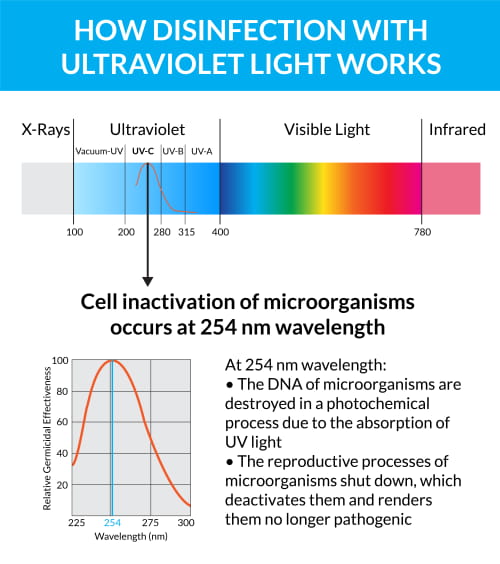If you're concerned about the quality of the air in your
home, you're not alone. Poor indoor air quality can lead to a range of health
problems, including sickness, allergies, asthma, and respiratory infections. Fortunately, there are several technologies available that can help improve the
air quality in your home. Below, we will discuss the benefits of ultraviolet
(UV) light, photocatalytic oxidation (PCO) technology, and carbon filtration
for a home's duct system.
Fortunately, there are several technologies available that can help improve the
air quality in your home. Below, we will discuss the benefits of ultraviolet
(UV) light, photocatalytic oxidation (PCO) technology, and carbon filtration
for a home's duct system.
How Does Ultraviolet Light Help Air Quality?
Ultraviolet (UV) Light is a type of electromagnetic radiation that is commonly used in air purification systems. UV light has been shown to be effective at significantly reducing bacteria, viruses, and other microorganisms that can be found in indoor air. When UV lights, specifically UV-C lights, are installed in a home's duct system, they can help prevent the spread of airborne illnesses.
One of the benefits of UV lights is that they are low maintenance. Once they are installed, they require very little attention or upkeep other than replacing the bulb once per year to ensure maximum effectiveness. UV light, when properly installed and used according to the manufacturer's instructions, provides a constant stream of UV radiation into the duct system, effectively treating the air.
How Does Photocatalytic Oxidation (PCO) Technology Help My Home’s Air?
Photocatalytic oxidation (PCO) technology is another air purification technology that can be used in a home's duct system. PCO technology works by using a photocatalyst (usually titanium dioxide) and UV light to create a chemical reaction that breaks down harmful pollutants in the air, such as volatile organic compounds (VOCs) and mold. Although VOCs are prevalent in most homes, we don’t see them, so we tend not to take steps to remove them. Adding PCO technology to your home will give you peace of mind that your home can be free from harmful VOCs that affect your family’s health. PCO technology is also highly effective at removing odors from indoor air, which is a common concern for many homeowners.
Does Carbon Filtration Remove Odors from My Home?
Carbon filtration is a type of air purification that uses
carbon to remove impurities from indoor air. Carbon filters work
 by trapping
pollutants in the tiny pores of the carbon, which can effectively remove odors
and harmful chemicals from the air.
by trapping
pollutants in the tiny pores of the carbon, which can effectively remove odors
and harmful chemicals from the air.
One of the benefits of carbon filtration is that it can be customized to fit a home's specific air purification needs. There are several types of carbon filters available, including Granular Activated Carbon (GAC), Powdered Activated Carbon (PAC), and Activated Carbon Fibers (ACF). The preferred option is Activated Carbon Fibers, as it is known to have a higher surface area compared to GAC and PAC, which can make it more effective at removing certain pollutants from the air.
Carbon filters are relatively easy to install and maintain. Many carbon filters can be easily replaced, which makes it simple to ensure that your home's air purification system is always working at peak efficiency.
Should I Combine UVC, PCO, and Carbon Filtration?
Combining UV-C light, carbon filtration, and photocatalytic oxidation (PCO) technology can provide a comprehensive air purification system that effectively removes a wide range of airborne pollutants from your indoor air. UV-C lights are effective at significantly reducing bacteria and viruses, while carbon filtration can remove odors from the air. PCO technology can break down harmful pollutants such as volatile organic compounds (VOCs) and mold. When these technologies are used together, they can create a highly effective air purification system that not only removes impurities from the air, but also helps to prevent the spread of airborne illnesses. By combining these technologies, you can breathe easier knowing that your indoor air quality is being effectively managed and controlled.
 US Dollars
US Dollars
